In June 1997, in a soccer match between France and Brazil, Roberto Carlos scored an impressive free kick. The given data: distance from the gate about 35 meters and a defense wall made from great players ( Zidane included). Yet, the Brazilian, after a moose run with the outside of his leg, launches a kick that reaches 137 kph and ends up in the net, after the ball avoids the wall.
Here we are, almost 20 years later, and sports commentators and experts are still discussing the physics behind his exceptional success. Did Carlos know about the kinematics and dynamics of his execution? Unlikely. One thing is certain—the execution was successful precisely because it didn’t defy physics’ regularities.
There is so much content out there, and within this sea of articles we want our own posts to miraculously stand out and be read by thousand of readers. The truth is, there is no secret recipe and most of the paths have been already tried.
Instead of trying to reinvent the wheel, you can take the wheel as it is and make the best of it.
You don’t learn how to think by memorizing the logic handbook, and you don’t learn how to swim watching a video. In both cases, you learn through practice and discipline.
As mentioned before, I personally don’t believe in a bulletproof technique that will instantly help you boost your content. However, I do believe that there is a framework that if followed, can help you craft new and unique content ideas that will eventually boost your content marketing.
In the following article, I will present efficient and easy to implement steps:
Step 1. Thoroughly Document Yourself on Your Niche to Find Inspiration
Whether you run a business or you are a content marketer who is interested in the content from a specific area, you first need to check out what is going on in that niche and find some inspiration from those findings. In both cases, correlating search trends with the most recent mentions on the web seems to be a great formula. And let me show you how:
Let’s assume I’m interested in the vegan niche, on which I would very much like to write an article. There are lots of possible starting points for documenting my piece of content, but I would choose vegan diets, as it seems that it would most represent the interests of my audience. However, it’s almost impossible not to be overwhelmed with information on a Google search – I’ll be returned over 14 million results on vegan diets.
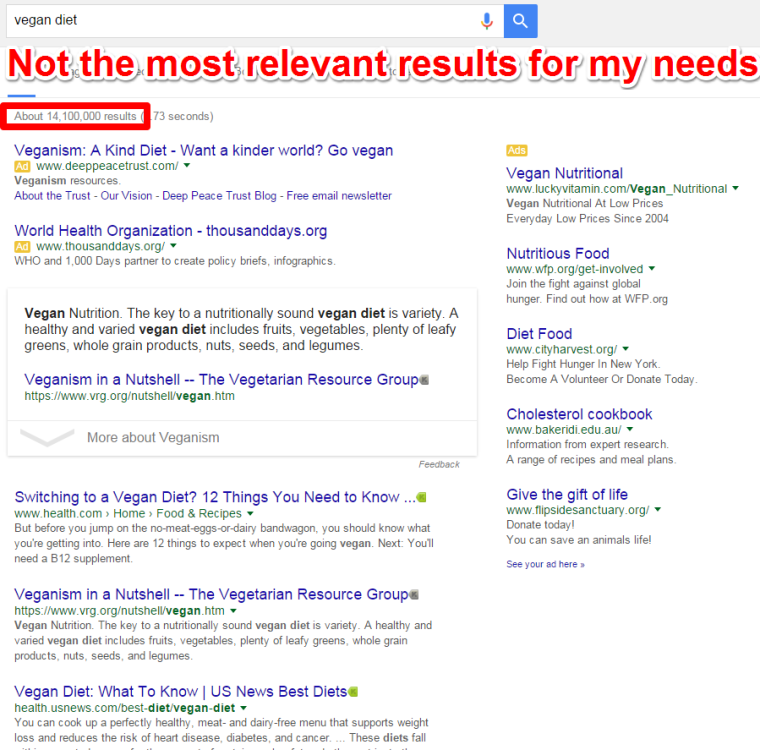
Which takes me right to the following point – what I can do in this case is search the web for the most recent results on the topic instead of the most appreciated ones. Knowing what other professionals in the niche have written the past few weeks will help me figure out my strategy from more perspectives:
a) not to be redundant compared to the ideas of my competitors
b) to be informed as to what the latest trends are in terms of vegan diets
c) to be appropriate and cohesive with these trends
I’ll use BrandMentions to spot the fresh mentions (I am the founder of the tool) and Google Trends to identify usage patterns.
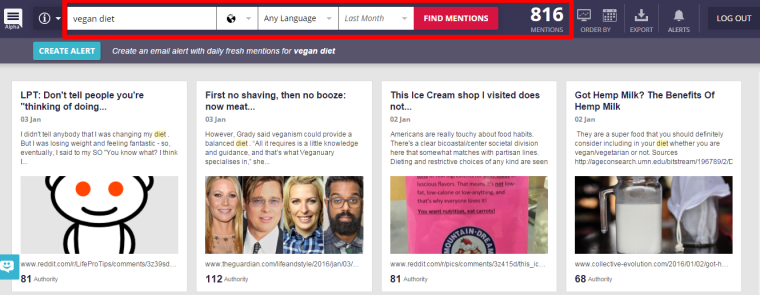
And supposing I would like to be truly thorough, I could go with my search a bit further and see if there is an interest in the same area, “vegan”, yet, on different subjects. We used Google Trends to compare “vegan diet” with other similar subjects and it turned out that “vegan recipe” might be another subject I should focus my attention on.
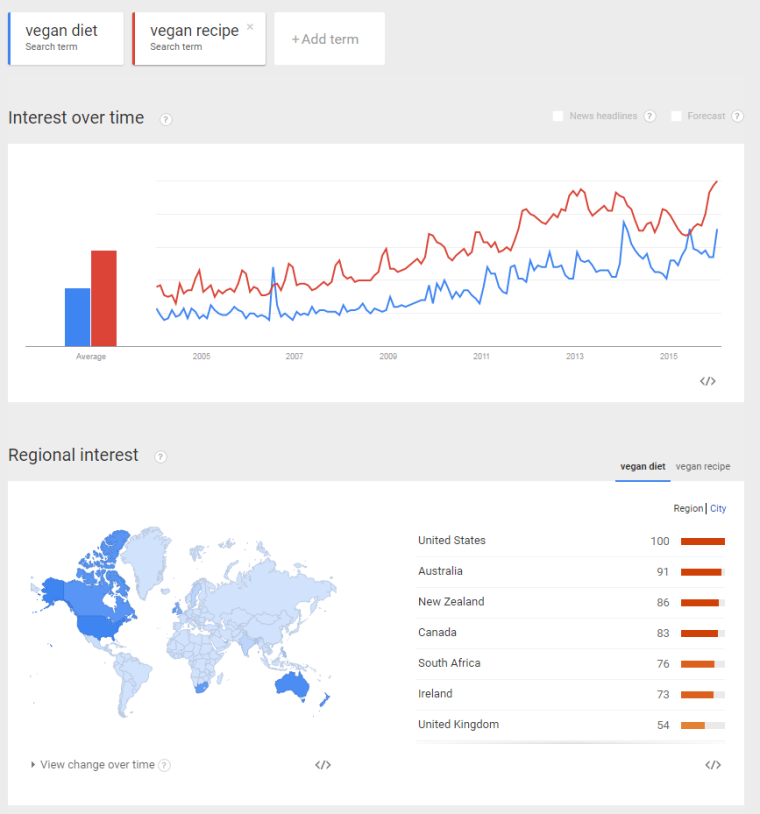
As you can see in the screenshot above, “vegan recipe” seems to be of high interest, even more trending than “vegan diet”. We can even see the regional interest of the topics we are interested in and afterwards search for mentions on specific area (if we are interested in one). Therefore, we can repeat the steps made with “vegan diet” and start looking for unique and new content ideas for “vegan recipe” as well.
Step 2. Use Google Analytics to Understand Your Users’ Behavior
You want to create new and unique content that your readers will appreciate and benefit from. First, you need to ask yourself if you know your audience. You might know a thing or two about the people that read your content (or the content from a certain website you are interested in), yet you might need to have a better understanding of them. Do they prefer a certain type of content? Is there a pattern to your most popular articles? A specific type of headlines or examples that generate more traffic?
Google Analytics comes in handy here. The basic version is free and it’s a solutions that might help you see what’s working and fix what’s not. All you need to do is add the website you are interested in and play around charts and statistics while trying to figure out info about your audience, preferences, behavior on the website, etc.
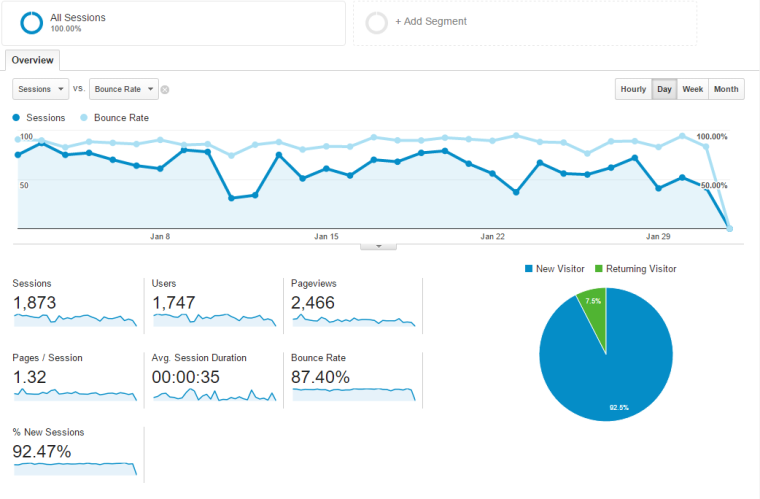 Let’s say we’re interested in traveling area articles. We want to boost our content marketing and find the best strategy to do this. But first, we need to take a look at what is currently going on. In the screenshot above we can see an overview of the overall visitors’ behavior on my website. I can easily see the up and down periods, the number of sessions or the bouncing rate.
Let’s say we’re interested in traveling area articles. We want to boost our content marketing and find the best strategy to do this. But first, we need to take a look at what is currently going on. In the screenshot above we can see an overview of the overall visitors’ behavior on my website. I can easily see the up and down periods, the number of sessions or the bouncing rate.
For instance, the small number of returning visitors (only 7%) might indicate that maybe I am not providing the appropriate content or I am not addressing it to the right audience. This statement is also backed by the high bouncing rate (the percentage of visitors to a particular website who navigate away from the site after viewing only one page.), around 87%.
Yet, as we take a closer look at our readers’ behaviour, we can find even more insightful info. Google Analytics has a section dedicated to user’s behavior. Once you are logged in the tool, search for the Behaviour category on the menu, on the left side, and after that select Site Content – All Pages to see how did the content from your pages perform. What is great about this is that you can easily see a top of your most successful articles but also additional data about them – number of pageviews, average time spent on page, etc.
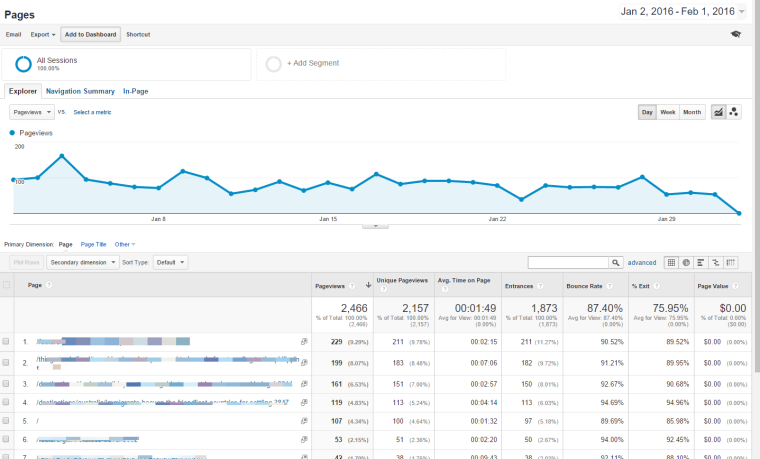
Step 3. Keep an Eye on Industry Challenges and Stay Connected With Your Niche
One of the most important attributes of relevant content is creating meaningful content for your readers. That includes responding to your audience’s threats, their biggest questions, solving their ambiguities and offering solution-oriented content. In each industry or niche there are recurrent topics that are debated over and over again for years. On one hand, that means the audience is interested in the subject, but also no one has “solved” the problem. You can be the one who addresses that issue and provides content your readers benefit from.
[pullquote]It is very likely that your audience will be searching for content solutions on several topics. If your content responds to those questions, not only you will provide a great user experience, but you will also be likely to be read, clicked, and followed in the future.[/pullquote]
For instance, in the SEO world there is a “debate” regarding disavowing or not the no-follow links. You will find this question placed in blog comments, forums, social media, and so on. The query “should I disavow nofollow links” is a very popular one. However, there is an article that responds to the user’s precise question and that post proved to be a popular one.
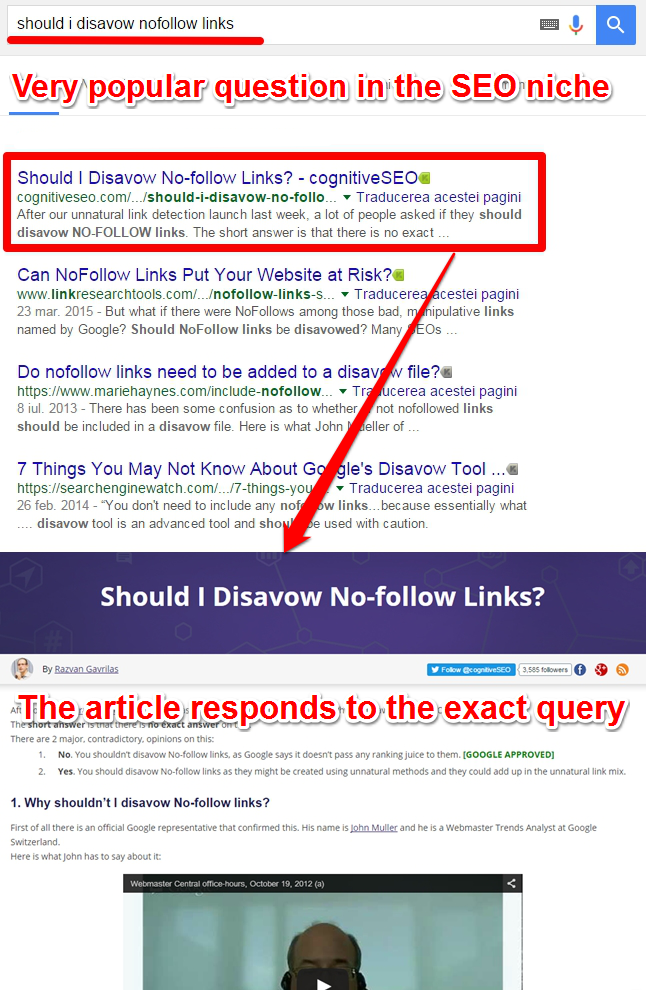
Also, attending industry events might give you some ideas for crafting new and unique content. Conferences, seminaries, classes, courses — they all can be a great source of inspiration when searching for content ideas.
Step 4. Talk to the Sales and Support Team
Through all its efforts, a company/business/website is trying to find a way to best reach its audience. Some efforts are sort of an “indirect” contact with the public (through online content, for instance) and some others are in direct contact with the user.
For instance, a blog post on “How to improve your conversion rate” is addressed directly to the audience, yet it doesn’t always come in direct contact with its readers. On the other hand, the people from the sales or support team generally talk directly to your audience. Therefore, while you are trying to gather as many info about your readers’ tastes and interests in content, they might have valuable information on their specific needs or technical impediments they are facing.
[pullquote]A discussion with the sales and support team might be a great opportunity for you to better understand your audience’s needs or challenges.[/pullquote]
Your discussion can concentrate but not be limited to this kind of topics:
- What are the main issues the users want solved?
- What type of info is the user most interested in?
- What kind of feedback is usually received?
- In what area of the industry is the user most interested in?
- What are the top reasons users don’t continue using the service?
- What are the users’ top likes and dislikes?
- What kind of marketing offers do prospects respond best to?
Step 5. Create a Content Strategy Calendar
Going through the steps mentioned above will help you find great article ideas that your readers will benefit from and be willing to share and promote. Yet, after collecting a bunch of great article ideas, you need to gather them together in a way that will be efficient and effective for your website or blog. Creating a content calendar is a method to get the best results out of your ideas.
“Content Strategy Calendar” might sound a bit pretentious and you might get discouraged or think it is a very complicated task. The truth is, even a simple Google Doc Spreadsheet can help you out. You can find several examples of content calendars out there. What you need to remember is for each article you are going to write, you have to take in consideration items like:
- What type of content is it?
- Where do you intend to publish it?
- What is the article’s audience?
- What is the purpose of the article?
- How and where are you going to promote it?
- What are the follow-up steps/ How are you going to scale the result?
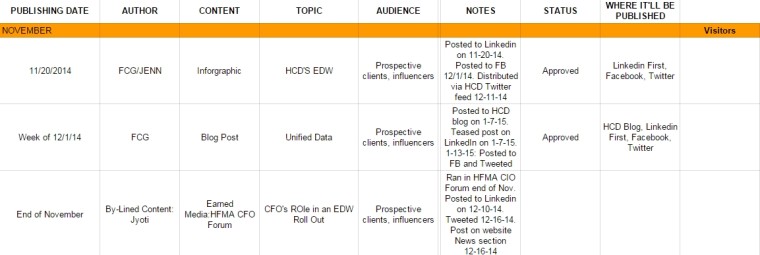
Conclusion
We’re drowning in a flood of content. There is so much content published every day begging for your attention that you could never hope to discover it all (or expect to consume it). When you are planning your content, the goal should be to produce one piece that is found nowhere else. If a dozens of other similar brands have tackled the same topics using the same perspective, the chances your content will be noticed are very low.
In this context, creating a content strategy that brings good results seems almost impossible. However, using a framework similar to the one mentioned in this article along with some of the tips for developing new content ideas will help you boost your content marketing.
Image Credits
Featured Image: Image by Razvan Gavrilas
All screenshots by Razvan Gavrilas. Taken March 2016





